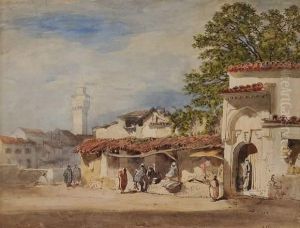Alphonse Dallemagne Paintings
Alphonse Dallemagne was a French painter known for his landscapes and historical scenes. Born on March 2, 1843, in Paris, France, he grew up during a period that was rich in artistic innovation and was exposed to the various currents of art that flowed through the city. Dallemagne's educational background and early training are not well-documented, and he remains a relatively obscure figure in art history.
Despite the lack of extensive personal details, Dallemagne's work speaks to a classical approach to painting, often reflecting the academic style that prevailed in French art during the 19th century. He was known to have exhibited at the Paris Salon, a prestigious annual and then biennial art show in Paris, which was the official art exhibition of the Académie des Beaux-Arts. Participation in the Salon was considered essential for any artist wishing to achieve recognition and success in France at that time.
In his paintings, Alphonse Dallemagne showed a preference for pastoral scenes, depicting rural life with a sense of tranquility and timelessness. He also painted historical buildings and ruins, revealing an interest in the French heritage and possibly the Romantic fascination with the past that was common among artists of his era. His technique was characterized by a careful attention to detail and a subdued palette that often conveyed a sense of harmony and order.
Dallemagne's career spanned a period of significant transition in the art world, including the rise of Impressionism and Post-Impressionism. However, he remained largely unaffected by these movements, maintaining his traditional style throughout his life. While he did not achieve the level of fame as some of his contemporaries, his work was appreciated by a segment of the art audience that favored the continuation of classical themes and techniques.
Alphonse Dallemagne passed away on October 26, 1933, leaving behind a modest but dedicated body of work that continues to be of interest to art historians and collectors who specialize in 19th-century French art. His legacy is that of a skilled painter who captured the essence of his time while adhering to the values of the academic tradition.
